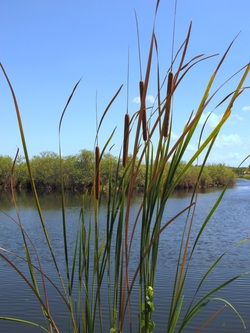 In South Florida, if you talk about invasive species people tend to think of the Indo-Pacific Lionfish or the Burmese Python. However, animals aren't the only possible invaders. The innocuous cattail (Typha spp.) is creating problems for many of the plants and animals in the Everglades. It isn't completely understood why the cattail population is booming. Most scientists suspect it has to do with changes in water quality--phosphorous pollution from nearby sugar farms is a likely culprit--but it may also be fueled by hydrological changes resulting from human alteration to the landscape. Dense stands of cattails are bad news for the Everglades, and in many cases they are outcompeting the native sawgrass which so many species rely on. The plants (algae, periphyton) that grow in the shallow waters of the Everglades rely on sunlight so they can photosynthesize, but dense cattail stands can block out the sun. That means less food and habitat for small fish and less prey for big fish. Cattails also impede movement of larger animals and wading birds, who are found in significantly lower numbers in areas of cattail dominance. There is some good news, though: since 1994 the government has been using phosphorous-hungry cattails to create buffer zones between the Everglades and sugar plantations, essentially using cattails as natural filters to clean the water. They had hoped to reduce the phosphorous level in runoff from 120 part per billion (ppb) when it entered the cattail buffer marsh to less than 50 at departure. It worked even better than expected, reducing phosphorous levels to under 25 ppb before releasing water into sawgrass habitat. Although this progress hasn't stopped the spread of cattails, it has helped slow it dramatically, beginning a course change that we all hope will lead to a healthier Everglades.
0 Comments
Leave a Reply. |
Field Notes
Archives
July 2021
Categories |
|
Partner with us! We are always looking for new schools, scientists, and non-profit organizations to partner with. Please contact us here to start a conversation.
Hear from us! Sign up for our newsletter to hear about what is happening at Field School as well as upcoming offers and specials. |

 RSS Feed
RSS Feed